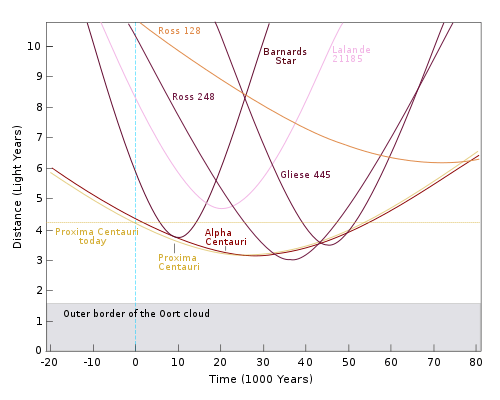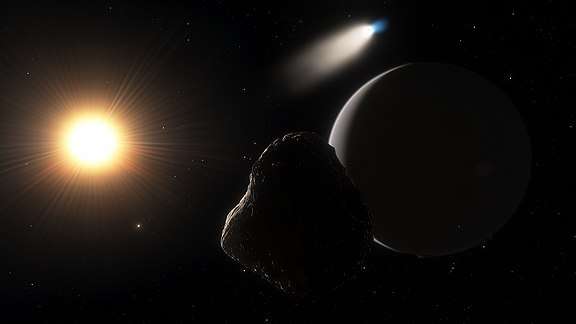Ross 248
Ross 248, also called HH Andromedae or Gliese 905, is a small star approximately 10.30 light-years (3.16 parsecs)[9] from Earth in the northern constellation of Andromeda. It was first catalogued by Frank Elmore Ross in 1926 with his second list of proper-motion stars;[10] on which count it ranks 261st in the SIMBAD database. It was too dim to be included in the Hipparcos survey.
| Observation data Epoch J2000 Equinox J2000 | |
|---|---|
| Constellation | Andromeda |
| Right ascension | 23h 41m 55.0361s[1] |
| Declination | +44° 10′ 38.825″[1] |
| Apparent magnitude (V) | 12.29[2] |
| Characteristics | |
| Spectral type | M6 V[3] |
| Apparent magnitude (J) | 12.3[2] |
| U−B color index | +1.48[2] |
| B−V color index | +1.92[2] |
| Variable type | Flare star |
| Astrometry | |
| Radial velocity (Rv) | –75.2 ± 3.7[4] km/s |
| Proper motion (μ) | RA: 112.692±0.153[1] mas/yr Dec.: −1592.055±0.112[1] mas/yr |
| Parallax (π) | 316.9558 ± 0.1260[1] mas |
| Distance | 10.290 ± 0.004 ly (3.155 ± 0.001 pc) |
| Absolute magnitude (MV) | 14.79[5] |
| Details | |
| Mass | 0.136[3] M☉ |
| Radius | 0.16[6] R☉ |
| Luminosity | 0.0018[7] L☉ |
| Surface gravity (log g) | 5.12[8] cgs |
| Temperature | 2,799[8] K |
| Rotational velocity (v sin i) | 1.2[3] km/s |
| Other designations | |
| Database references | |
| SIMBAD | data |
Within the next 80,000 years, Ross 248 is predicted to be nearest star to the Sun for a brief time, overtaking the current nearest star and triple system, Alpha Centauri. Despite its proximity it is too dim to be seen with the naked eye.[11]
Characteristics
This star has about 12% of the Sun's mass and 16% of the Sun's radius, but only 0.2% of the Sun's luminosity. It has a stellar classification of M6 V,[3] which indicates it is a type of main-sequence star known as a red dwarf. This is a flare star that occasionally increases in luminosity.[12] With high probability, there appears to be a long-term cycle of variability with a period of 4.2 years. This variability causes the star to range in visual magnitude from 12.23 to 12.34.[13] In 1950, this became the first star to have a small variation in magnitude attributed to spots on its photosphere.[14]
Examining the proper motion of Ross 248 has found no evidence of a brown dwarf or stellar companion orbiting between 100–1400 AU[15], and other unsuccessful searches have been attempted using both the Hubble Space Telescope Wide Field Planetary Camera[5] and by near-infrared speckle interferometry.[16] Long-term observations by the Sproul Observatory show no astrometric perturbations by any unseen companion.[14]
Distance from the Sun

The space velocity components of this star in the galactic coordinate system are [U, V, W] = [–32.9 ± 0.7, –74.3 ± 1.3, 0.0 ± 1.4] km/s.[9] The trajectory of Ross 248 will bring it closer to the Solar System. In 1993, Matthews projected that in about 33,000 years it would enter a period of about 9,000 years as the closest star to the Sun, as close as 3.024 light-years (0.927 parsecs) in 36,000 years.[17]
Any future spacecraft that escaped the Solar System with a velocity of 25.4 km/s would reach this star 37,000 years from now, when the star just passes its nearest approach. By comparison, the Voyager 1 has an escape velocity of 16.6 km/s.[18]
Field star
Ross 248 is located nearly along the line of sight to star PLX 5735 but is not physically associated.
| Name | PLX 5735 |
|---|---|
| Right ascension | 23h 41m 54s |
| Declination | +44° 14′ 00″ |
| Apparent magnitude (V) | 12.6 |
| Spectral type | A5 |
| Absolute stellar parallax | 0.7846 |
| Distance in light years | 4,200 |
| Database references | Simbad |

References
- Brown, A. G. A.; et al. (Gaia collaboration) (August 2018). "Gaia Data Release 2: Summary of the contents and survey properties". Astronomy & Astrophysics. 616. A1. arXiv:1804.09365. Bibcode:2018A&A...616A...1G. doi:10.1051/0004-6361/201833051. Gaia DR2 record for this source at VizieR.
- "V* HH And". SIMBAD. Centre de données astronomiques de Strasbourg. Retrieved 2009-09-06.
- Jenkins, J. S.; Ramsey, L. W.; Jones, H. R. A.; Pavlenko, Y.; Gallardo, J.; Barnes, J. R.; Pinfield, D. J. (October 2009), "Rotational Velocities for M Dwarfs", The Astrophysical Journal, 704 (2): 975–988, arXiv:0908.4092, Bibcode:2009ApJ...704..975J, doi:10.1088/0004-637X/704/2/975
- Deshpande, R.; Martín, E. L.; Montgomery, M. M.; Osorio, M. R. Zapatero; Rodler, F.; Burgo, C. del; Bao, N. Phan; Lyubchik, Y.; Tata, R.; Bouy, H.; Pavlenko, Y. (2012). "Intermediate Resolution Near-infrared Spectroscopy of 36 Late M Dwarfs". The Astronomical Journal. 144 (4): 99. arXiv:1207.2781. Bibcode:2012AJ....144...99D. doi:10.1088/0004-6256/144/4/99. ISSN 1538-3881.
- Schroeder, Daniel J.; et al. (2000). "A Search for Faint Companions to Nearby Stars Using the Wide Field Planetary Camera 2". The Astronomical Journal. 119 (2): 906–922. Bibcode:2000AJ....119..906S. doi:10.1086/301227.
- Johnson, H. M.; Wright, C. D. (November 1983). "Predicted infrared brightness of stars within 25 parsecs of the Sun". Astrophysical Journal Supplement Series. 53: 643–711, 705. Bibcode:1983ApJS...53..643J. doi:10.1086/190905.
- West, Frederick R. (June 1999). "Monitoring Nearby Stars for Transits by Extrasolar Jovial Planets, II: Transits of M-Type (Red) Dwarf Stars by Close Extrasolar Giant (Jovian) Planets". The Journal of the American Association of Variable Star Observers. 27 (1): 77–78. Bibcode:1999JAVSO..27...77W.
- Cenarro, A. J.; et al. (2007). "Medium-resolution Isaac Newton Telescope Library of Empirical Spectra – II. The Stellar Atmospheric Parameters". Monthly Notices of the Royal Astronomical Society. 374 (2): 664–690. arXiv:astro-ph/0611618. Bibcode:2007MNRAS.374..664C. doi:10.1111/j.1365-2966.2006.11196.x.
- Leggett, S. K. (September 1992). "Infrared colors of low-mass stars". Astrophysical Journal Supplement Series. 82 (1): 351–394. Bibcode:1992ApJS...82..351L. doi:10.1086/191720.
- Ross, Frank E. (February 1926). "New proper-motion stars, (second list)". Astronomical Journal. 36 (856): 124–128. Bibcode:1926AJ.....36..124R. doi:10.1086/104699.
- Routray, Sudhir K. (2004), Light Years Away: The Whole Creation at a Glance, iUniverse, p. 31, ISBN 0-595-33582-9
- Poveda, Arcadio; Allen, Christine; Herrera, Miguel Angel (1996). "Chromospheric Activity, Stellar Winds and Red Stragglers". Workshop on Colliding Winds in Binary Stars to Honor Jorge Sahade. 5. Universidad Nacional Autonoma de Mexico. pp. 16–20.
- Weis, Edward W. (March 1994). "Long term variability in dwarf M stars". Astronomical Journal. 107 (3): 1135–1140. Bibcode:1994AJ....107.1135W. doi:10.1086/116925.
- Lippincott, S. L. (July 1978). "Astrometric search for unseen stellar and sub-stellar companions to nearby stars and the possibility of their detection". Space Science Reviews. 22 (2): 153–189. Bibcode:1978SSRv...22..153L. doi:10.1007/BF00212072.
- Hinz, Joannah L.; et al. (February 2002). "A Near-Infrared, Wide-Field, Proper-Motion Search for Brown Dwarfs". The Astronomical Journal. 123 (4): 2027–2032. arXiv:astro-ph/0201140. Bibcode:2002AJ....123.2027H. doi:10.1086/339555.
- Leinert, C.; Henry, T.; Glindemann, A.; McCarthy, D. W. Jr. (September 1997). "A search for companions to nearby southern M dwarfs with near-infrared speckle interferometry". Astronomy and Astrophysics. 325: 159–166. Bibcode:1997A&A...325..159L.
- Matthews, R. A. J. (Spring 1994). "The Close Approach of Stars in the Solar Neighborhood". Quarterly Journal of the Royal Astronomical Society. 35 (1): 1. Bibcode:1994QJRAS..35....1M.
- West, F. R. (March 1985). "A Suggested Future Space Mission to the Low-Luminosity Star Ross 248=Gliese 905". Bulletin of the American Astronomical Society. 17: 552. Bibcode:1985BAAS...17..552W.
Sources
- Riaz, Basmah; Gizis, John E.; Harvin, James (2006). "Identification of New M Dwarfs in the Solar Neighborhood". The Astronomical Journal. 132 (2): 866–872. arXiv:astro-ph/0606617. Bibcode:2006AJ....132..866R. doi:10.1086/505632. Table 1.
- Dittmann, Jason A.; Irwin, Jonathan M.; Charbonneau, David; Berta-Thompson, Zachory K. (2014). "Trigonometric Parallaxes for 1507 Nearby Mid-to-late M Dwarfs". The Astrophysical Journal. 784 (2): 156. arXiv:1312.3241. Bibcode:2014ApJ...784..156D. doi:10.1088/0004-637X/784/2/156. Table with parallaxes.